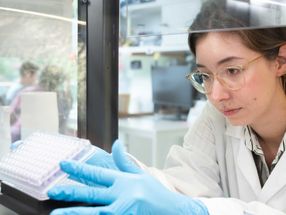Highly Reactive Catalyst Enables Labeling of Biologically Active Compounds
New reactivity enables conversion of seemingly “unreactive” molecule parts
Advertisement
In a recent issue of the “Journal of the American Chemical Society”, the research group of Prof. Dr. Johannes Teichert (Chemnitz University of Technology, Organic Chemistry) discloses the results of a joint research effort together with research partners from the working group of Prof. Dr. Fabian Dielmann (University of Innsbruck, Inorganic Chemistry). They present their results on a new, bifunctional copper catalyst. The novel, “bifunctional” copper-based catalyst molecule consists of two subunits and enables the hydrogenation of other molecules, by first activating and then transferring molecular hydrogen (H2). “In principle, one part of the catalysts, namely the the copper atom, activates hydrogen - we have been researching this type of reactivity in our research group for a long time. In most cases, however, high pressures of H2 were required for this, necessitating the use of high-pressure reaction vessels (autoclaves). And that is impractical. We have now discovered that a second catalytically active unit within the same catalyst, a so-called iminopyridine, boosts the reactivity of the copper, so that the reaction now takes place at a low H2 pressure of 1 bar. This makes the method easier to use in the laboratory,” reports Teichert. The team makes use of their knowledge on bifunctional catalyst design that had already been reported on.
New reactivity enables conversion of seemingly “unreactive” molecule parts
The new catalyst displays such a high activity that even unreactive functional groups within other molecules can be efficiently converted. These functional groups, so-called enamides, are often structural components of biologically active substances, precisely because they are so unreactive. The new copper catalyst now enables the direct hydrogenation of exactly these groups, which were previously considered unreactive, for the first time under these mild conditions. This can be used for further modification of biologically active molecules. The present work shows that a large number of medicinal compounds can be converted in this way. “In principle, in addition to the simple diversification of known active substances, this strategy now also opens up the possibility of isotope labeling if deuterium, i.e. heavy hydrogen, is used instead of hydrogen itself. This is of great importance for research into biological processes and in particular for degradation studies of biologically active substances,” says Teichert.
Cooperation between differently specialized researchers across borders
This work is the result of a scientific collaboration crossing borders. “In principle, this is a typical example of joint molecular research: one of the two catalyst building blocks comes from TU Chemnitz, the other from Innsbruck,” says Teichert. “We didn't expect this hybrid catalyst to be so active.” The findings now form the basis for further research projects by the international working group, for example within the EU research network CATALOOP, which is led by Teichert. According to Teichert, especially the aforementioned labeling experiments will be studied in more detail.
Original publication
Mahadeb Gorai, Jonas H. Franzen, Philipp Rotering, Tobias Rüffer, Fabian Dielmann, Johannes F. Teichert; "Broadly Applicable Copper(I)-Catalyzed Alkyne Semihydrogenation and Hydrogenation of α,β-Unsaturated Amides Enabled by Bifunctional Iminopyridine Ligands"; Journal of the American Chemical Society, Volume 147, 2025-4-16

































































